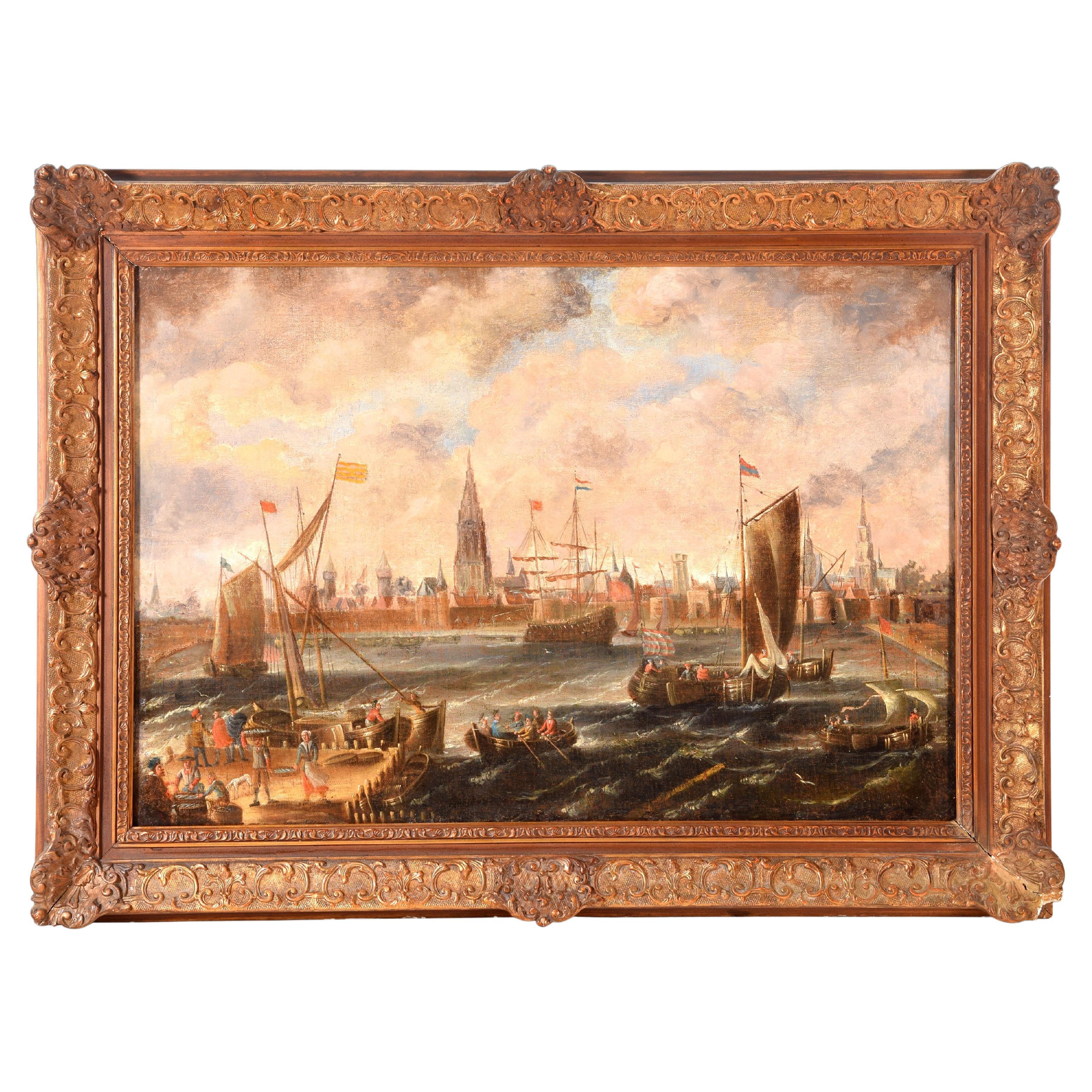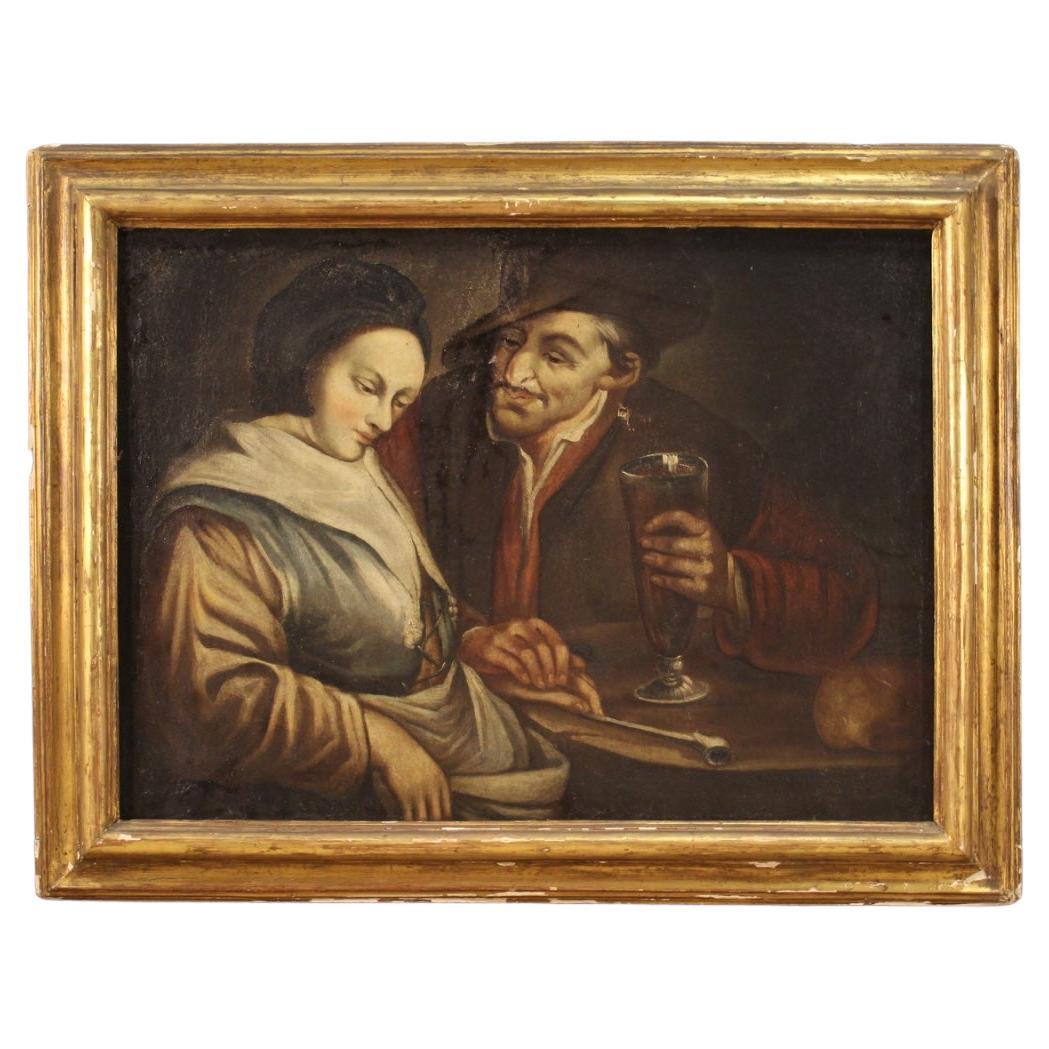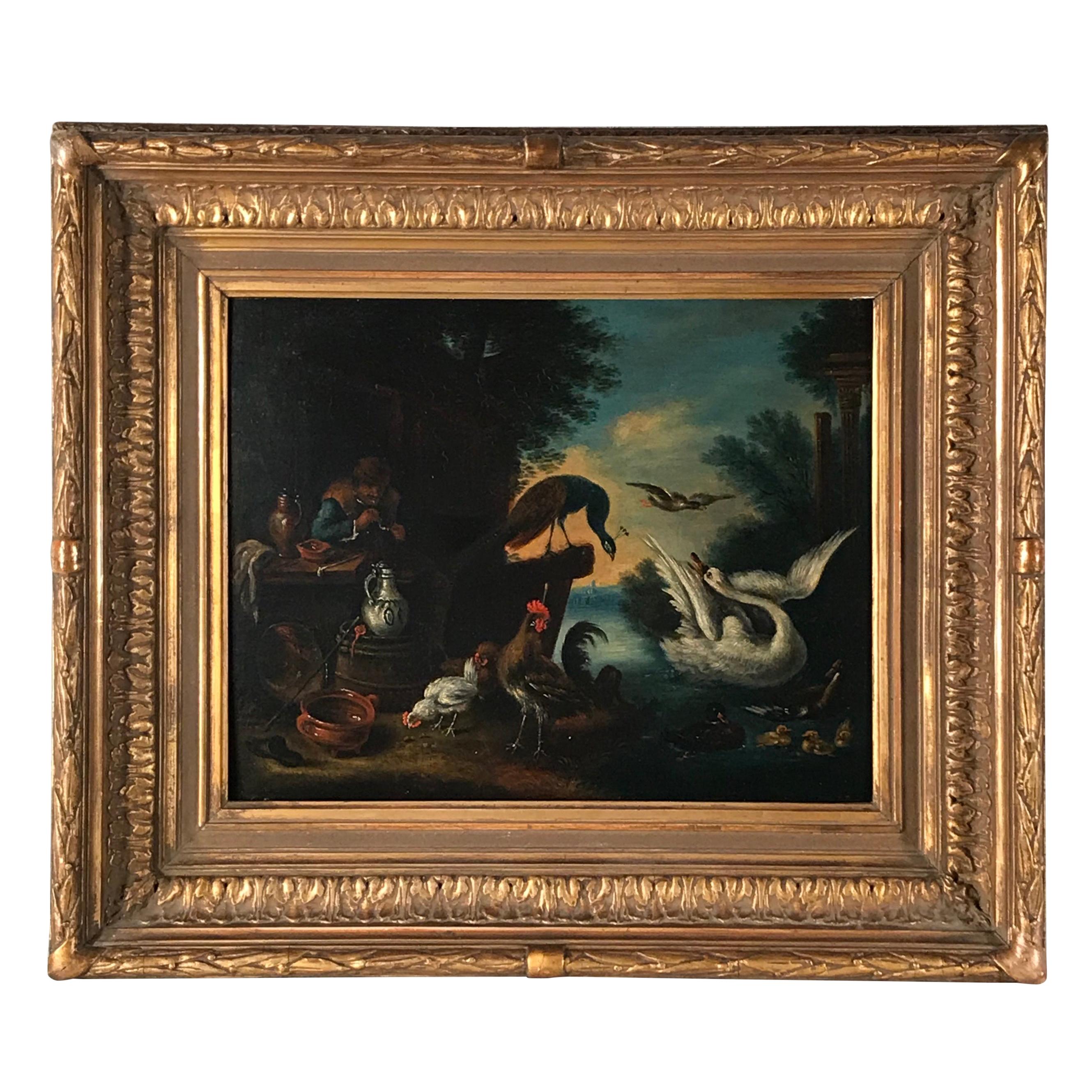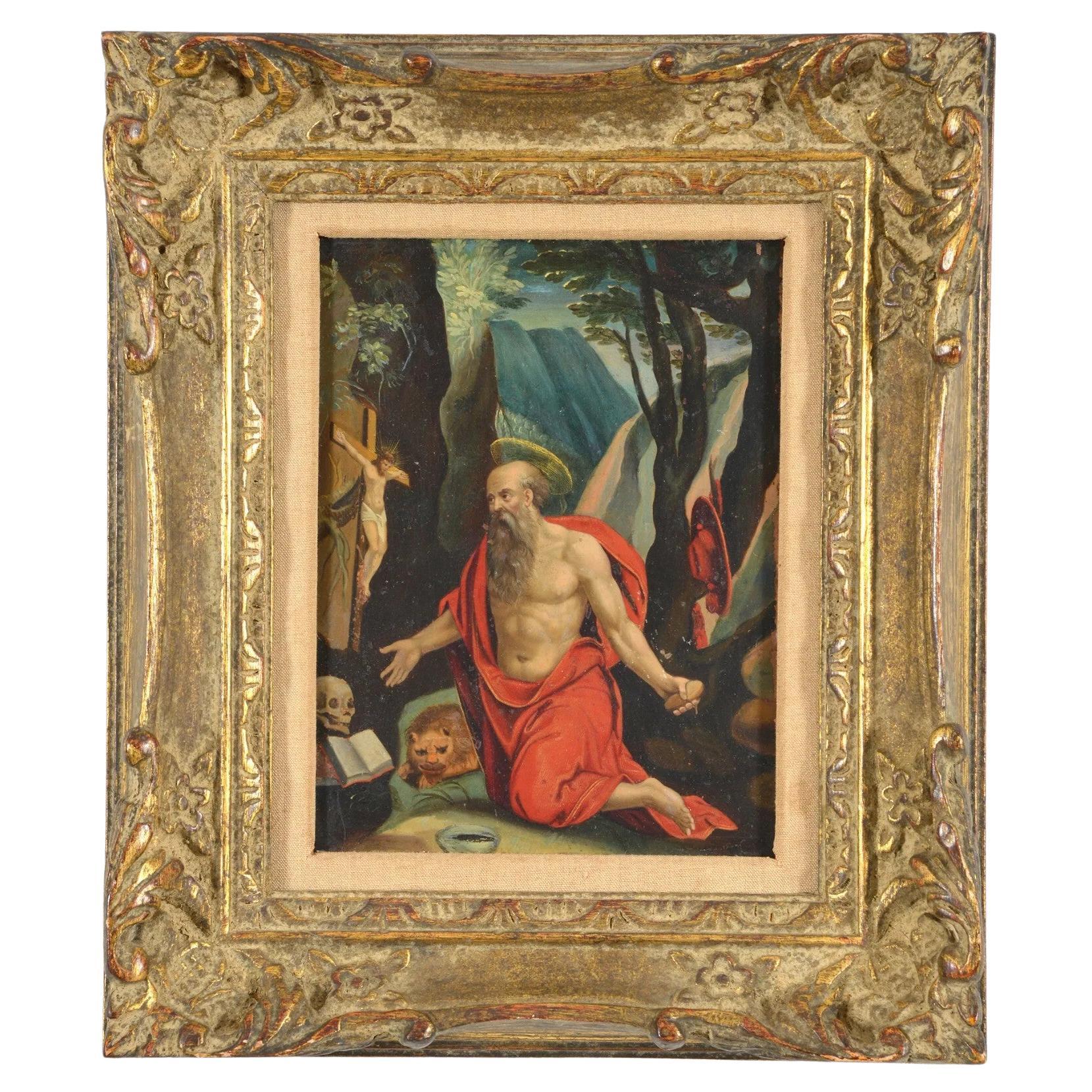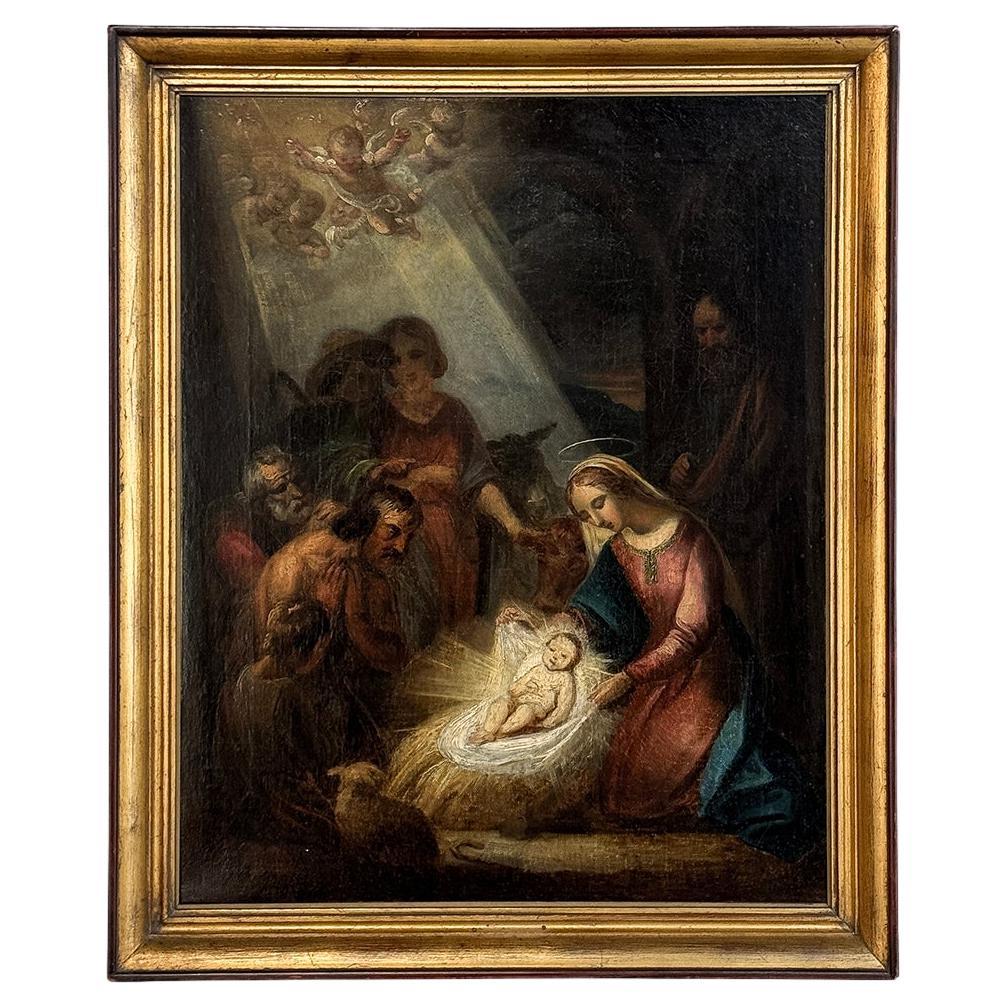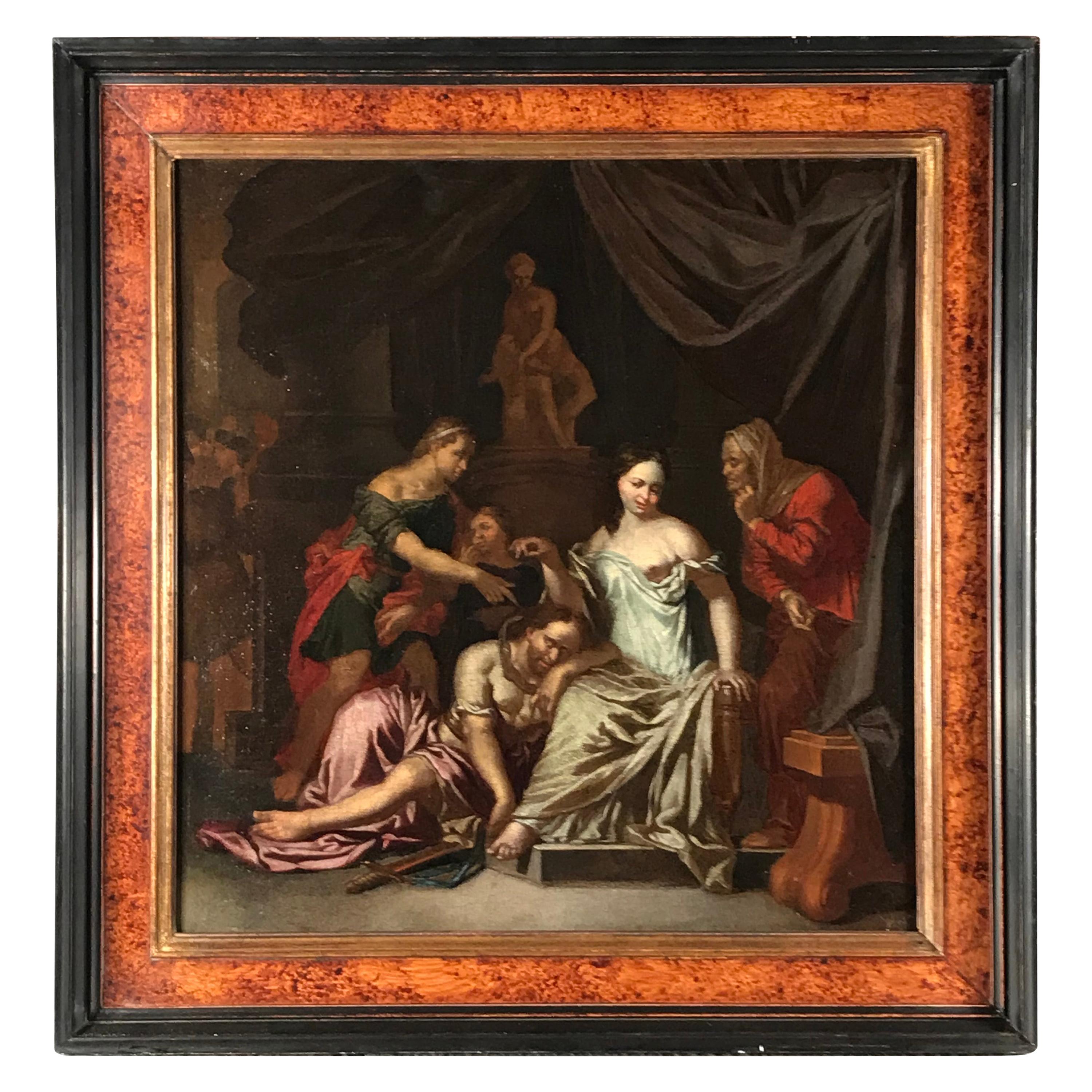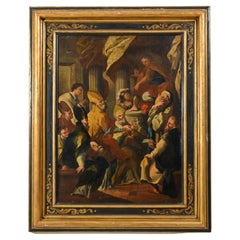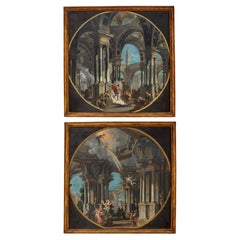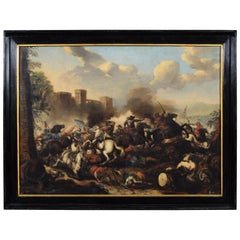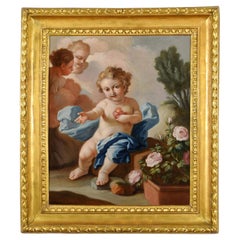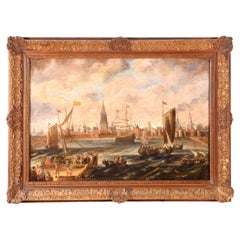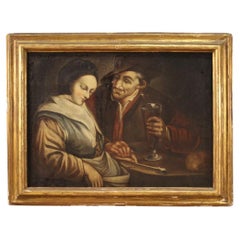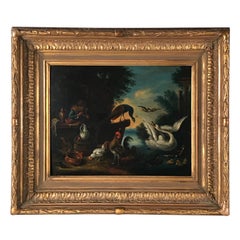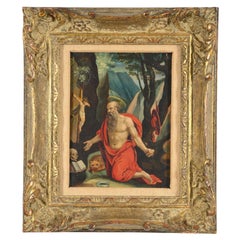Items Similar to 18th Century, Flemish Oil Painting with the Interior of Antwerp Cathedral
Want more images or videos?
Request additional images or videos from the seller
1 of 15
18th Century, Flemish Oil Painting with the Interior of Antwerp Cathedral
About the Item
"Interior of the Cathedral of Our Lady of Antwerp",
Flemish painter active in the 18th Century
Oil on canvas
Size: with frame cm 180 x 143, canvas cm 163 x 125 cm
The fine painting depicts the interior of the Antwerp Cathedral in the Flanders region of Belgium.
The point of view of the observer, slightly raised from that of the faithful, allows to observe the interior of the nave, with at the bottom the iconostasis and beyond the presbytery, the choir and the apse with large windows. On the left, it’s possible to see some chapels and the side aisle and the opening of the transept.
In the space described there are some characters that animate the composition. They are faithful, religious figures; in the foreground some noble clothes according to the fashion widespread around the middle of the seventeenth century and, on the left, a poor beggar.
Today, the Cathedral of Our Lady is the largest cathedral in Belgium and the main Catholic place of worship in the Flemish city of Antwerp and stands behind the Grote markt, the main square of the city. It represents a superb example of Gothic architecture and is one of the greatest masterpieces of the Brabant Gothic style. Begun the building of the church in 1352, on a previous Romanesque building, the choir was completed in 1415. The body of the naves was finished in 1487 and the transept was worked there until 1495. In 1521, after about 170 years of work, the yard was completed. Then, the 7 side aisles were built and the choir was enlarged by adding a new outer ring of radial chapels. In 1559 it became a cathedral. The church represents a new type of conception of the interior space: the seven naves are divided by large pillars polystyles beam that, without capitals, they are inserted directly at the vaults and the ogival arches of the central nave are exceptionally wide.
There are several Flemish painters who represented the interior of the cathedral of Antwerp between the 16th and 18th Centuries. These include Paul Vredeman De Vries, Peeter I Neeffs, Peeter II Neeffs, James Goodwyn Clonney, Sebastiaan Vrancx, Hendrik van Steenwijck II. A work by the baroque painter Hendrik van Steenwijck II (Antwerp 1580?- Londres ou La Haye 1649), dated 1746, represents the same point of view as the interior of the church. Even the furnishings and the architecture described, which have undergone some modifications over the centuries, appear the same described in the painting in question. For these details, for the pictorial style the work can be dated to the second half of the 18th Century.
- Dimensions:Height: 56.3 in (143 cm)Width: 70.87 in (180 cm)Depth: 2.37 in (6 cm)
- Style:Baroque (Of the Period)
- Materials and Techniques:
- Place of Origin:
- Period:
- Date of Manufacture:18th Century
- Condition:We apologize for any translation errors in English.
- Seller Location:IT
- Reference Number:1stDibs: LU4405217574241
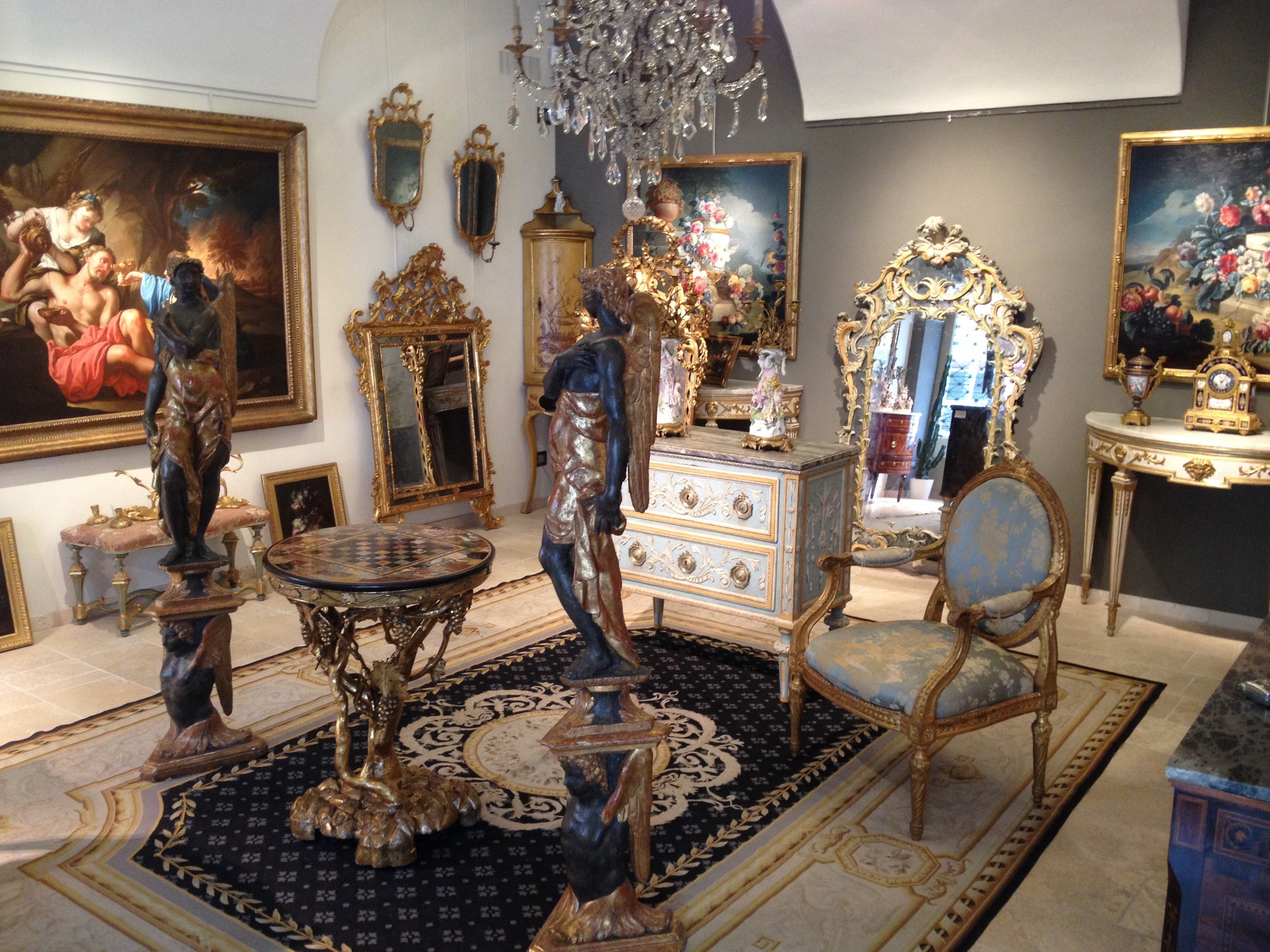
About the Seller
5.0
Platinum Seller
Premium sellers with a 4.7+ rating and 24-hour response times
Established in 1980
1stDibs seller since 2019
54 sales on 1stDibs
Typical response time: <1 hour
- ShippingRetrieving quote...Shipping from: Italy
- Return Policy
Authenticity Guarantee
In the unlikely event there’s an issue with an item’s authenticity, contact us within 1 year for a full refund. DetailsMoney-Back Guarantee
If your item is not as described, is damaged in transit, or does not arrive, contact us within 7 days for a full refund. Details24-Hour Cancellation
You have a 24-hour grace period in which to reconsider your purchase, with no questions asked.Vetted Professional Sellers
Our world-class sellers must adhere to strict standards for service and quality, maintaining the integrity of our listings.Price-Match Guarantee
If you find that a seller listed the same item for a lower price elsewhere, we’ll match it.Trusted Global Delivery
Our best-in-class carrier network provides specialized shipping options worldwide, including custom delivery.More From This Seller
View All18th Century, Italian painting with Saint Nicholas and the miracle of the brick
Located in IT
18th Century, Italian painting with Saint Nicholas and the miracle of the brick
Oil on canvas; Frame cm H 136 x W 109 x D 10. Canvas cm H 100 x W 74
The oil on canvas painting, with...
Category
Antique 18th Century Italian Baroque Paintings
Materials
Canvas
18th century, Couple of Italian Paintings Capriccio with Mythological Scenes
Located in IT
Couple of architectural capriccio with mythological scenes, oil on canvas, painter from Bologna active in the 18th century
The two large and valuable pantings depict two architectur...
Category
Antique Early 18th Century Italian Baroque Paintings
Materials
Canvas
$60,187 Sale Price
20% Off
18th Century Italian Oil on Canvas Painting with Battle by Antonio Calza
By Antonio Calza
Located in IT
Antonio Calza (Italy, Verona, 1653-18th April 1725)
"Battle between Christian and Turkish cavalry with castle"
The painting depicts a bloody battle between Christian and Turkish cavalry. Characterized by dynamism, intensity of color and light, the main scene occupies the lower horizontal section of the canvas, optically interrupted by the black fumes of the shots from which emerge, on the left, the towers of a fortress. On the right, in the distance you can see the combat in progress in the countryside, beyond which you can see the pale presence of hills that create a fifth, marking the horizon. To frame the scene contributes to the left, against light and in the foreground, a portion of the wall. The painter, however, introduces a horse on the ground, of which we see only the back, a ruse to involve the observer making him become active and participate in the scene. In the foreground, lifeless bodies, wounded horses and, scattered on the ground, weapons and a drum enhance the drama of the clash.
The excitement and expressive force, the intense chromatic range attentive to the conditions of light and the fine brushstrokes, decisive and dramatic, suggests the attribution to Antonio Calza, one of the most important painters of battles of the seventeenth century, excellent student and continuator of the greatest interpreter of the genre, Jacques Courtois called il Borgognone (Saint-Hyppolite 1621 - Rome 1676). Il Borgognone, although not having had a real school or direct students, places itself as a primary reference point by the Italian and foreign "battaglisti".
The genre of battle painting found great success in the collections of the Italian and European nobility of the seventeenth and eighteenth centuries. The battles of the Italian Renaissance, in which the scene converged towards a precise protagonist, evolve towards a type of combat "without hero". The bloody realism of the details and the dynamic development of the narrative confuse the figure of the protagonist, when present, to give importance to the swirl of horses and armed fighters, among which, moreover, does not emerge a winner.
The certain documents relating to the life and movements of Antonio Calza are scarce; it was equally difficult to reconstruct, from the critics, a catalogue of autograph works. Through paintings in private collections, in museums and paintings passed on the antiques market it has been possible to identify a copious corpus of works that can be traced back to his hand. The work of art historians, together with that of antique dealers, in conferring proper attributions in order to best outline the figure of Calza, continues but studies are still in progress. In this sense, the work of Giancarlo Sestieri should certainly be noted, who investigated the artistic production of the battaglisti and Calza, thus allowing the comparison of the numerous photographic works reported, to identify and recognize the stylistic qualities that distinguish the corpus of paintings assigned to him today.
Antonio Calza was born in 1653 in Italy, in Verona and in 1664 he entered the school of Carlo Cignani in Bologna, dedicating himself to painting battles and landscapes. He then perfected in Rome, where he knew the works of the then undisputed head of the sector, Jacques Courtois called the Burgundian. In 1675 he returned to Verona and married an 88-year-old widow who, dying, left him a rich inheritance. Much appreciated by the nobility and the bourgeoisie, he received numerous commissions. Bartolomeo Dal Pozzo (Le Vite de' pittori, de gli scultori et architetti veronesi, 1718) praises "three great paintings of battles...
Category
Antique Late 17th Century Italian Baroque Paintings
Materials
Canvas
$31,482 Sale Price
20% Off
18th Century, Italian painting with Sacred Heart of the Child Jesus by Pietro Ba
By Pietro Bardellino
Located in IT
Pietro Bardellino (Italy - Naples, 1732 - 1806), attr., Sacred Heart of the Child Jesus
Measurements: with frame, cm L 86 x H 99 x P 8; only the canvas, cm L 78 x H 64
The painting, made in oil on canvas, represents the Sacred Heart of the Child Jesus. Stylistically the work is attributable to Pietro Bardellino (Italy, Naples, 1732 - Naples, 1806), a pupil of Francesco De Mura and considered by critics one of the most gifted and sensitive exponents of the Rococo style in Naples.
The canvas represents the Child Jesus, surrounded by flowers in an outdoor setting, while showing the sacred heart. The canvas has a well-balanced color and a strong sweetness of the child’s traits, which with the complicit gesture of the right hand, involves the viewer in the intimate and delicate sharing of the garden in which he sits. The roses, in addition to being a beautiful piece of still life, contribute to enrich the Christological message, being bearers of symbolic meanings. Marian attributes par excellence, are often side by side with Christ, whose thorns foreshadow the Passion. In the canvas, on the top left, two cherubim are observed: among them, according to the Old Testament, is God: the author therefore puts into place an iconographic and iconological hyperbole that amplifies its meaning. The iconographic theme of the Child Jesus with the Sacred Heart in his hand spread between the second half of the eighteenth century and the first of the following century. With the worship of the Sacred Heart of Jesus, the Catholic Church intends to honour the Heart of Jesus Christ, one of the organs symbolizing his humanity, which by intimate union with the Divinity, has the right to worship and love of the Saviour for men, of which His Heart is the symbol. It represents one of the fundamental devotions of Christian life, as it manifests the true face of God, who is prodigal and boundless love. It was the French mystic Saint Margaret Mary Alacoque...
Category
Antique Mid-18th Century Italian Baroque Paintings
Materials
Canvas
$15,278 Sale Price
20% Off
18th Century, Italian Pair of Oil on Canvas Paintings by Francesco Simonini
By SIMONINI
Located in IT
Francesco Simonini (Parma, 16 June 1686 - Parma, 1766)
“The rest of the soldiers” and “The march of soldiers”
oil on canvas
cm 40 x 58 and 40 x 60 ; frame: h 52,5 x W 70,5 x D 6 an...
Category
Antique Early 18th Century Italian Baroque Paintings
Materials
Canvas
$27,084 Sale Price
35% Off
17th Century, Flemish Painting Oil on Copper with Allegory by Pieter Van Lint
By Peter Van Lint
Located in IT
Pieter Van Lint (Antwerp, 1609-1690)
Allegory of industriousness leading to peace and abundance
Oil on copper; frame measures cm H 132 x W 159 x D 8, copper measures cm H 104 x W 130
Artwork signed (bottom center) "P.V. Lint F./ en A.B"
The important and valuable painting, made of oil on copper, depicts the Allegory of industriousness that leads to peace and abundance.
The work is signed in the bottom and center "P V Lint", or Pieter Van Lint (Antwerp, 28 June 1609 - Antwerp, 25 September 1690), famous Flemish painter and designer active in Antwerp in the second half of the seventeenth century.
Van Lint elaborates a complex and articulated composition in which he inserts several figures also drawn from mythology to propose the allegorical message of industriousness that leads to peace and abundance. The artistic style of the author is characterized by meticulous realism and by the careful attention to detail and the rendering of the materials that make up the objects described. As we will see later, every detail represented within the work contains a symbolic and allegorical meaning that reinforces the message that already the same figures express.
The remarkable dimensions of the copper support, not so infrequent in the artistic production of the artist, contribute to make the work of great value: Unfortunately, many of these artifacts have been lost because copper was often recovered in times of war and famine, and reused to obtain weapons and common tools. The copper foil proved to be ideal for oil painting because it constituted a non-absorbent support, rigid, smooth and characterized by the same reddish coloring that was used for the preparation of funds. The major production centers were Antwerp, Hamburg and Amsterdam, although the technique was widely used in Italy.
The considerable cost of the material indicates a wealthy client, interested in possessing a valuable and durable work over time, this characteristic that the metal foil has more than the canvas.
The painting is known to scholars. It is recorded in the catalog of the artist of the RKD Netherlands Institute for Art History (with measures 104 x 129 cm). He also appeared on the French antiques market...
Category
Antique Mid-17th Century Belgian Baroque Paintings
Materials
Copper
You May Also Like
View of the pier of Antwerp. Oil on canvas. Flemish school, 18th century.
Located in Madrid, ES
View of the pier of Antwerp. Oil on canvas. Flemish school, 18th century.
Numerous ships and boats appear in the landscape, accompanied by small characters. In the background a city...
Category
Antique 18th Century European Neoclassical Paintings
Materials
Other
18th Century Oil on Canvas Framed Flemish Painting Interior Scene, 1750
Located in Vicoforte, Piedmont
Antique Flemish painting from the 18th century. Framework oil on canvas depicting an interior scene of a tavern with characters of good pictorial quality. Nice size and pleasant impact painting, for antique dealers, interior decorators and collectors of old Dutch painting...
Category
Antique 1750s Italian Paintings
Materials
Canvas
Unknown Flemish Artist, 18th Century
Located in Belmont, MA
Unknown Flemish Artist, Belgium 18th century, in the right part of the painting the artist represented a man sitting in front of a tavern. He is surrounded by Delft baroque earthenware pitchers and plates. The right side of the painting shows different types of birds, among them chicken, a swan, ducks and a peacock. The painter was here definitely inspired by the 17th century painter Melchior de...
Category
Antique 1770s Belgian Baroque Paintings
Materials
Hardwood
17th/18th century Flemish old master oil painting of Saint Jerome
Located in New York, NY
17th/18th century Flemish old master painting of Saint Jerome in a landscape with objects. Oil on copper. Framed. Light inscription on reverse. Sight: 9 x 7in. Overall: 14 x 12in.
Co...
Category
Antique 17th Century Unknown Paintings
Materials
Copper
18th Century Framed Oil Painting on Canvas of Nativity ~ Flemish School
Located in Dallas, TX
18th Century Framed Oil Painting on Canvas of Nativity ~ Flemish School is an amazingly inspirational work, displaying the influences of the Old Masters in the setting, composition, ...
Category
Antique Late 18th Century Dutch Aesthetic Movement Paintings
Materials
Canvas, Giltwood
Unknown Flemish Artist, 17th-18th Century
Located in Belmont, MA
Unknown Flemish artist, 17th-18th century, “Judith and Holofernes”, oil on canvas 20.47 x 19.68 inches (52 x 50 cm) (lined), not signed. The painting c...
Category
Antique Late 17th Century Belgian Baroque Paintings
Materials
Canvas
